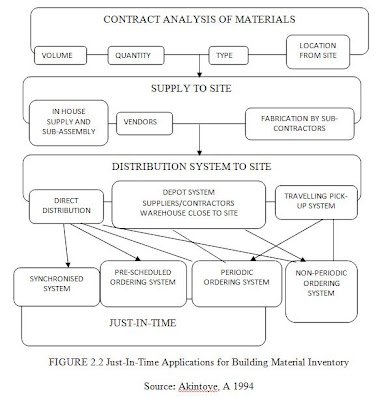Overview of Just-In-Time
According to Joshi (1990), Just-In-Time is a set of philosophies developed in Japan designed for efficient and quality production. Although perception of Just-In-Time vary enormously, it is generally agreed that it improve quality preventive maintenance, employee motivation and morale, worker involvement and commitment and decreases inventory level, lead time, throughout or set up time, defects and ultimately costs. The Just-In-Time approach represents major changes in management philosophy to reduce slack resources, create more fluid and responsive organizational systems in place of highly structured, formal organizational systems, and involve people at all levels in operations management and decision making. Based on Ohno(1998) and Suzaki(1987) have outlined detailed analyses of sources of waste in manufacturing that are consider invaluable inputs to Just-In-Time. These ways are over production, waiting, transportation, processing production, waiting, transportation, processing, stalls, motion, and making defective products. Lea and Parker (1989) illustrated Just-In-Time as dealing with the creation of manageable environment – in which participants in production process seek to eliminate waste and keep things simple – to effect a continuous improvement in overall business. Schonberger (1982) explained the idea of Just-In-Time in a simple fashion; to produce and deliver finished goods just in time to be sold, sub-assemblies just in time to be assembled into finished goods, and purchasing materials just in time to be transformed into fabricated parts. Willis and Suter (1989) pointed out that Just-In-Time simply means to provide exactly what is needed when it is needed. Scott (1986) described this as a ‘wasteless’ programmed. Ptak (1991) summarized the by-product of Just-In-Time implementation as a major reduction in lead time, inventory and required manufacturing space yielding a more competitive company. Plenert (1990) recognized three different concepts of Just-In-Time : kanban, production planning and global management philosophy. Kanban allows the scheduling of inventory movement through the shop floor with the use of a material-movement-tracking device. Figure 1 shows Just-In-Time implications for various functioning aspects of manufacturing. To realize its potential and achieve total quality, Schneider and Leatherman (1992) have maintained that Just-In-Time must involve all aspects of organization (total business approach) leading to excellent communication and inter-functional cooperation. The main features of Just-In-Time (Schonberger 1982 ; Hutchins 1990) can be expressed as :
i. Minimum inventory
ii. Minimum work in progress
iii. Information driven ‘pull’ system
iv. Close knit team
v. Close relation with suppliers
vi. Operator responsibility
vii. Responsiveness
viii. Reorganized work space
FIGURE 2.1 Just-In-Time approach to total business functions
Source: Akintoye, A. 1994

